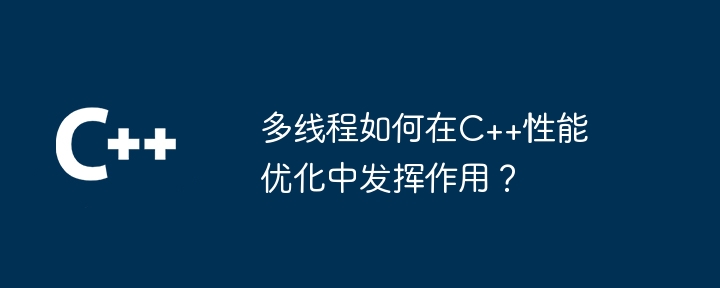
The principle of multi-threading to improve C performance is to allow multiple threads to execute at the same time and make full use of multi-core processors. Multithreading creates multiple execution streams, each thread has its own call stack and local variables. Threads communicate through shared memory and use synchronization mechanisms to avoid data races. For example, when processing an image in parallel, the image is divided into sub-regions and multiple threads are used to process the sub-regions simultaneously. Multithreading can significantly reduce the execution time of computationally intensive tasks such as image processing.

#How does multi-threading improve C performance?
In modern computer systems, multi-threading has become an indispensable means to improve performance. By allowing multiple threads to execute simultaneously, C programs can take full advantage of multi-core processors, improving overall efficiency.
How multi-threading works
Multi-threading is a concurrent programming technology that allows the creation of multiple execution streams (threads) in a process. Each thread has its own call stack and local variables and can execute independently.
Communication and data exchange between threads through shared memory. When two threads access shared data at the same time, synchronization mechanisms (such as mutexes, semaphores, etc.) need to be used to avoid data competition.
Practical Case: Parallel Processing of Images
In order to demonstrate the application of multi-threading in C performance optimization, we take parallel processing of images as an example:
#include <opencv2/opencv.hpp>
#include <vector>
#include <thread>
using namespace cv;
void processImage(Mat& img) {
// 对图像执行处理...
}
int main() {
Mat image = imread("image.jpg");
// 将图像分割成多个子区域
int num_threads = std::thread::hardware_concurrency();
int subwidth = image.cols / num_threads;
std::vector<std::thread> threads;
for (int i = 0; i < num_threads; i++) {
threads.push_back(std::thread(processImage,
std::ref(image(Rect(subwidth * i, 0, subwidth, image.rows)))));
}
// 等待所有线程执行完成
for (auto& thread : threads) {
thread.join();
}
// 将处理后的子区域合并回原图像
// ...
imwrite("processed_image.jpg", processedImage);
return 0;
}In this example, we divide the image into multiple sub-regions and use multiple threads to process these sub-regions simultaneously. Through parallel processing, we can significantly reduce image processing time.
Conclusion
Multi-threading is an effective technique that can improve the performance of C programs. By allowing multiple threads to execute simultaneously, programs can take full advantage of multi-core processing power, thereby improving overall efficiency. In computationally intensive tasks like image processing, multithreading can bring significant performance improvements.
The above is the detailed content of How does multithreading play a role in C++ performance optimization?. For more information, please follow other related articles on the PHP Chinese website!
 What are the differences between c++ and c language
What are the differences between c++ and c language
 Recommended learning order for c++ and python
Recommended learning order for c++ and python
 Cost-effectiveness analysis of learning python and c++
Cost-effectiveness analysis of learning python and c++
 Is c language the same as c++?
Is c language the same as c++?
 Which is better to learn first, c language or c++?
Which is better to learn first, c language or c++?
 The difference and connection between c language and c++
The difference and connection between c language and c++
 C++ software Chinese change tutorial
C++ software Chinese change tutorial
 Cost-effectiveness analysis of learning python, java and c++
Cost-effectiveness analysis of learning python, java and c++




